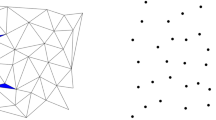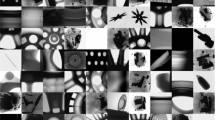Abstract
In this paper, a new algorithm with extrapolation process for computing the ray/surface intersection is presented. Also, a ray is defined to be the intersection of two planes, which are non-orthogonal in general, in such a way that the number of multiplication operations is reduced. In the preprocessing step, NURBS surfaces are subdivided adaptively into rational Bézier patches. Parallelepipeds are used to enclose the respective patches as tightly as possible. Therefore, for each ray that hits the enclosure (i.e., parallelepiped) of a patch the intersection points with the parallelepiped's faces can be used to yield a good starting point for the following iteration. The improved Newton iteration with extrapolation process saves CPU time by reducing the number of iteration steps. The intersection scheme is faster than previous methods for which published performance data allow reliable comparison. The method may also be used to speed up tracing the intersection of two parametric surfaces and other operations that need Newton iteration.
Similar content being viewed by others
References
Glassner A (ed.). Introduction to Ray Tracing. Academic Press, USA, 1989.
Ortega J M, Rheinbooldt W C. Iterative Solution of Nonlinear Equations in Several Variables. Academic Press, USA, 1970.
Faux I D, Pratt M J. Computational Geometry for Design and Manufacture. Ellis Horwood, UK, 1981.
Farin G. Curves and Surfaces for Computer Aided Geometric Design. Academic Press, USA, 1988.
Nishita T, Sederberg T W, Kakimoto M. Ray tracing trimmed rational surface patches. InProc. of SIGGRAPH'90, also inComputer Graphics, 1990, 24(4): 337–345.
Barth W, Sturzlinger W. Efficient ray tracing for Bézier and B-spline surfaces.Computer & Graphics, 1993, 17(4): 423–430.
Giger C. Ray tracing polynomial tensor product surfaces. InProc. of Eurographics 1989, Hansmann, Hopgood, and Strasser (eds.), North-Holland, Amsterdam, 1989, 125–136.
Sweeney M, Bartels R. Ray tracing free-form B-spline surfaces.IEEE CG & A, 1986, 6: 41–49.
Toth D. On ray tracing parametric surfaces. InProc. of SIGGRAPH'85, San Francisco, CA, July 22–26, 1985; also inComputer Graphics, 1985, 19(3): 171–179.
Cohen E L, Lyche T, Riesenfeld R. Discrete B-splines and subdivision techniques in computeraided geometric design and computer graphics.Computer Graphics and Image Processing, 1980, 14(2): 87–111.
Kajiya J. Ray tracing parametric patches. InProc. of SIGGRAPH'82, Boston, MA, July 26–30, 1982; also inComputer Graphics, 1982, 16(3): 245–254.
Whitted T. An improved illumination model for shaded display.CACM, 1980, 23(6): 96–102.
Rogers D. Procedural Elements for Computer Graphics. McGraw-Hill, New York, 1985, 296–305.
Woodward C. Ray Tracing Parametric Surfaces by Subdivision in Viewing Plane. InTheory and Practice of Geometric Modeling, W. Strasser, Seidel H P (eds.), Springer-Verlag, 1989, 273–290.
Sederberg T W, Nishita T. Curve intersection using Bézier clipping.Computer-Aided Design, 1990, 22(9): 538–549.
Joyce D C. Survey of extrapolation processes in numerical analysis.SIAM Review, 1971, 13(4): 435–490.
Deng J. Extrapolation Methods and Their Applications (in Chinese). Shanghai Science & Technology Press, China, 1973.
Qin Kaihuai, Fan Gang, Sun Cai. Extrapolating acceleration algorithms for finding B-spline intersections using recursive subdivision techniques.J. of Computer Science and Technology, 1994, 9(1): 70–85.
Boehm W. Inserting new knots into B-splines curves.Computer-Aided Design, 1980, 12(4): 199–201.
Endle R, Sommer M. Classification of ray-generators in uniform subdivisions and octrees for ray tracing.Computer Graphics Forum, 1994, 13(1): 3–19.
Amanatides J, Woo A. A fast voxel traversal algorithm for ray tracing. InEUROGRAPHICS'87: Proc. of the European Computer Graphics Conference and Exhibition, Marechal G (ed.), Amsterdam, 1987, 3–10.
Cleary J G, Wyvill G. Analysis of an algorithm for fast ray tracing using uniform space subdivision.The Visual Computer, Springer-Verlag, 1988, (4): 65–83.
Snyder H, Barr A H. Ray tracing complex models containing surface tessellations. InProc. of SIGGRAPH'87, Anaheim, California; also inComputer Graphics, 1987, 21(4): 119–128.
Fujimoto A, Tanaka T, Iwata K. ARTS: Accelerated ray-tracing system.IEEE CG & A, 1986, 16–26.
Yagel R, Cohen d, Kaufmann A. Discrete ray tracing.IEEE CG & A, 1992, 19–22.
Arvo J, Kirk D. Fast ray tracing by ray classification.Computer Graphics, 1987, 21(44): 55–64.
Tiller W. Rational B-splines for curve and surface representation.IEEE CG & A, 1983, 3(10): 61–69.
Piegl L. On NURBS: A survey.IEEEE CG & A, 1991, (1): 55–71.
de Boor C. On calculating with B-splines.J. Approximation Theory, 1972, 6(1): 50–62.
Cox M G. The numerical evaluation of B-splines.J. Inst. Mathematics and Applications, 1972, (10): 134–149.
Voloboj A G. The method of dynamic palette construction in realistic visilization systems.Computer Graphics Forum, 1993, 12(5): 289–296.
Heckbert P. Color image quantization for frame buffer display.ACM Computer Graphics (SIGGRAPHY 82), 1982, 16(3): 297–304.
Rockwood A, Heaton K, Davis T. Real-time rendering of trimmed surfaces. InProc. of SIGGRAPH'89, Boston, MA, July 31–August 4, 1989; also inComputer Graphics, 1989, 23(3): 107–117.
Crow F. The origins of teapot.IEEEE CG & A, 1987, 7(1): 8–19.
Qin Kaihuai. New methods for interpolating NURBS curves and surfaces*. Darmstadt, Germany, Oct. 1993.
Qin Kaihuai, Sun Jiaguang, Wang X. Representing conics using NURBS of degree two.Computer Graphics Forum, 1992, 11(5): 285–291.
Piegl L, Tiller W. Curve and surface constructions using rational B-splines.Computer-Aided Design, 1987, 19(9): 485–496.
Brezinski C, Rieu A C. The solution of systems of equations using the ε-algorithm, and an application to boundary-value problems.Mathematics of Computation, 1974, 28(127): 731–741.
Joy K I, Bhetanabhotla M N. Ray tracing parametric surface patches utilizing numerical techniques and ray coherence. InProc. of SIGGRAPH'86; also inComputer Graphics, 1986, 20(4): 279–285.
Author information
Authors and Affiliations
Additional information
Project supported by the National Natural Science Foundation of China under grant number 69473010.
Qin Kaihuai obtained his Ph.D. degree in computer-aided manufacturing from Tsinghua University in 1990. He is now an Associate Professor in computer science and technology at Tsinghua University. His research areas include computer graphics, geometric modeling, spline curves and surfaces (epsecially NURBS surfaces), nueral network, scientific visualization, virtual reality, CAD/CAM.
Gong Minglun is a graduate student of Department of Computer Science and Technology, Tsinghua University.
Tong Geliang is a graduate student of Department of Computer Science and Technology, Tsinghua University.
Rights and permissions
About this article
Cite this article
Qin, K., Gong, M. & Tong, G. Fast ray tracing NURBS surfaces. J. of Compt. Sci. & Technol. 11, 17–29 (1996). https://doi.org/10.1007/BF02943518
Received:
Revised:
Issue Date:
DOI: https://doi.org/10.1007/BF02943518




